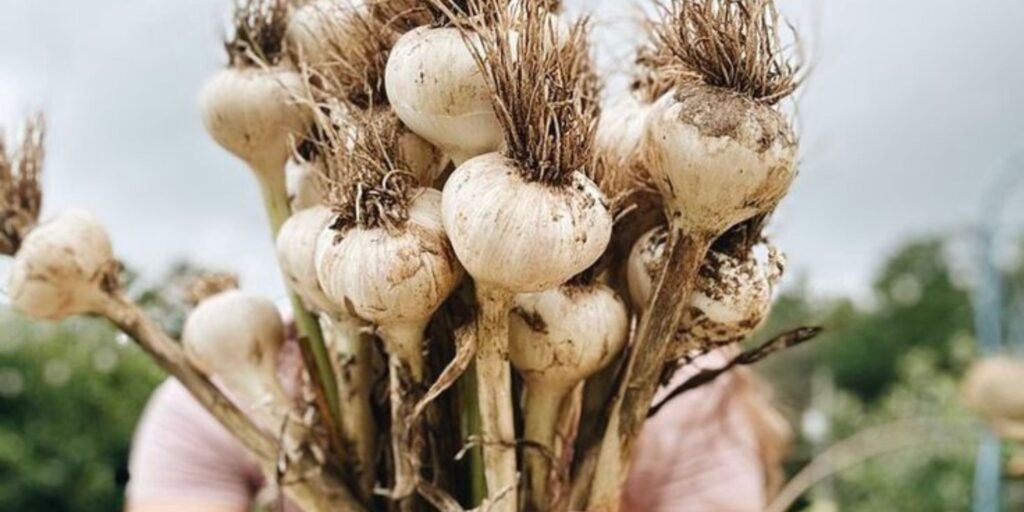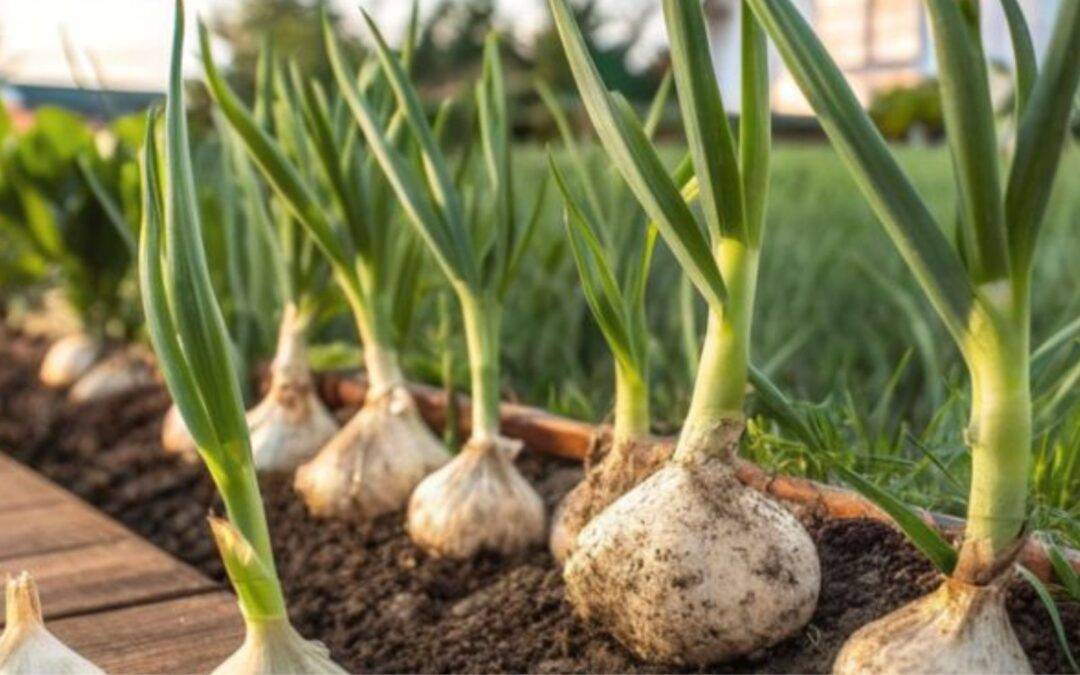Introduction
Garlic is a versatile and easy-to-grow plant that not only adds flavor but also enhances the nutrition of your garden. Whether you’re a seasoned gardener or a complete beginner, growing garlic can be a highly rewarding experience. In fact, it’s a fantastic option for anyone looking to grow their own food with minimal effort. Moreover, garlic is known for its numerous health benefits, making it a valuable addition to any garden. In this guide, we’ll walk you through every step you need to take to get started. From choosing the right variety to planting and harvesting, you’ll find all the tips and tricks you need to grow a thriving crop of garlic. By the end of this guide, you’ll be equipped with the knowledge to cultivate your own garlic, ensuring a bountiful harvest that can be enjoyed throughout the year.
Why You Should Grow a Garlic Plant in Your Garden
Growing garlic offers several benefits. First, it’s an easy plant to cultivate, requiring minimal attention. Second, garlic has numerous culinary and medicinal uses. From adding flavor to dishes to improving heart health, garlic has earned its place in gardens worldwide. Third, garlic helps repel pests, which can protect your other plants from harmful insects.
Garlic also grows well in a variety of climates, making it a great choice for most gardeners. It’s a low-maintenance crop that doesn’t need a lot of water or care once planted. Plus, with a little patience, you’ll be able to harvest your fresh garlic.
How to Plant and Care for Garlic: A Step-by-Step Guide

Planting garlic requires the right conditions and timing. Here’s a simple breakdown of the process:
1. Choose the Right Garlic Variety
Garlic comes in two main types: softneck and hardneck. Softneck varieties are ideal for warmer climates, while hardneck varieties grow best in cooler areas. Hardneck garlic tends to have a stronger flavor, while softneck garlic is easier to store and has a milder taste.
2. Select Your Planting Site
Garlic thrives in well-drained, loamy soil with good organic matter. It needs at least 6 hours of sunlight a day. Choose a location that’s not too wet and has good air circulation.
3. Prepare the Soil: Garlic Plant
Before planting, work compost or organic matter into the soil to improve its texture. Garlic prefers slightly acidic to neutral soil (pH 6.0–7.0). If your soil is too acidic, add lime to raise the pH.
4. Plant the Garlic Cloves
Separate the garlic bulb into individual cloves. Each clove will grow into a new garlic plant. Plant cloves about 2 inches deep and 4–6 inches apart, with the pointy end facing up. Space rows about 12–18 inches apart. Garlic does best in cool weather, so plant in late fall or early spring, depending on your climate.
5. Water and Mulch
After planting, water the garlic well. Keep the soil moist but not soggy. Mulching helps retain moisture and suppress weeds. Straw, leaves, or grass clippings make excellent mulch choices.
6. Monitor Growth
Garlic requires minimal care, but it is important to watch out for pests and diseases. Check for weeds regularly and remove them promptly. If you notice any yellowing or wilting leaves, adjust watering or check for disease.
7. Harvesting Your Garlic

Garlic is ready to harvest when the lower leaves start to yellow and die back, but the upper leaves remain green. This usually happens in late spring or early summer, depending on when you planted the cloves. Carefully dig up the garlic bulbs with a spade or fork, taking care not to damage them.
Garlic Planting Techniques: Best Practices for a Healthy Harvest
To get the best results, follow these planting techniques:
- Rotate Crops: Avoid planting garlic in the same spot every year to prevent soil depletion and disease buildup.
- Soil Preparation: Ensure the soil is loose and free of large clumps to allow the garlic roots to spread.
- Watering: Garlic doesn’t need frequent watering, but it requires consistent moisture during the growing season.
- Pruning Scapes: Hardneck garlic produces flower stalks (scapes). Cut them off to encourage larger bulbs and enhance flavor.
By following these practices, you can ensure a successful garlic harvest with large, flavorful bulbs.
Garlic Plant Varieties: Choosing the Best Type for Your Garden
The type of garlic you choose will depend on your location and climate. Let’s look at the two primary varieties:
Softneck Garlic
- Best For: Warmer climates.
- Flavor: Mild and sweet.
- Storage: Stores well for several months.
- Varieties: ‘Artichoke’ and ‘Silverskin’ are common softneck varieties.
Hardneck Garlic
- Best For: Cooler climates.
- Flavor: Strong, spicy flavor.
- Storage: Stores for a shorter period compared to softneck varieties.
- Varieties: ‘Rocambole’ and ‘Porcelain’ are popular hardneck types.
Choose the variety that best suits your climate and storage needs. Both types offer unique flavors and benefits.
Top Benefits of Growing Garlic Plant in Your Garden

Garlic isn’t just delicious—it’s packed with benefits. Here’s why growing garlic is a good idea:
1. Health Benefits
Garlic is known for its medicinal properties. It contains compounds like allicin, which have been linked to improved heart health, enhanced immune function, and anti-inflammatory effects. It may also help lower blood pressure and cholesterol.
2. Pest Control
Garlic acts as a natural pesticide. Its strong scent repels insects and keeps pests away from other plants. You can even make a garlic spray to deter aphids and other garden bugs.
3. Low Maintenance
Once planted, garlic requires little care. It grows well in many climates and doesn’t need constant attention, making it perfect for busy gardeners.
4. Improved Soil Health
Garlic has deep roots that help break up compacted soil. When the plants decompose, garlic adds organic matter to the soil, improving overall soil quality for future crops.
Common Problems with Garlic Plants and How to Solve Them
Though garlic is relatively easy to grow, it can face some challenges. Here’s how to address common issues:
1. Yellowing Leaves
Yellowing leaves may indicate overwatering or poor drainage. Ensure the soil isn’t waterlogged and that the plant has good airflow. If the issue persists, check for fungal diseases like rust or mildew.
2. Pests
Garlic is relatively pest-resistant, but certain insects, such as thrips and aphids, may target it. Use organic insecticides or neem oil to keep them at bay. Also, consider introducing beneficial insects, like ladybugs, to your garden.
3. Diseases
Garlic can suffer from fungal diseases, such as white rot or downy mildew. To avoid these, rotate crops each year and plant disease-free cloves. If you spot signs of disease, remove infected plants immediately to prevent spread.
Garlic Plant Care: How to Grow Garlic Successfully in Containers or Outdoors
You don’t need a large garden to grow garlic. Containers can work just as well as outdoor beds. Here’s how to grow garlic in both environments:
Growing Garlic in Containers
- Choose a Large Pot: Select a container that’s at least 10 inches deep to accommodate the garlic’s roots.
- Good Drainage: Ensure the pot has drainage holes to prevent waterlogging.
- Soil: Use a well-draining potting mix combined with compost to enrich the soil.
- Care: Container-grown garlic still requires plenty of sunlight and regular watering, though not excessive.
Growing Garlic Outdoors
- Planting Location: Choose a sunny spot with well-drained soil.
- Spacing: Allow plenty of space between each clove to ensure good airflow and prevent disease.
- Mulching: Mulch around your garlic to keep the soil cool and moist during the growing season.
Garlic grows just as well in containers as it does in the ground. With proper care, you can expect a good harvest.
The Science Behind Garlic Plant: Growth, Benefits, and Nutritional Value
A unique set of processes drives Garlic’s Growth. It starts as a clove, which develops roots and shoots as it grows. Over time, the plant forms bulbs, which are made up of smaller cloves. Garlic thrives in cool temperatures, with the best Growth occurring in the spring and fall.
Nutritionally, garlic is a powerhouse. It’s rich in vitamins like B6 and C, as well as minerals such as manganese and selenium. The allicin compound in garlic offers antioxidant and anti-inflammatory properties, making it a key ingredient in both cooking and natural medicine.
Harvesting Your Garlic Plant
Timing is everything when it comes to harvesting garlic. You don’t want to pull it too early or too late. Typically, garlic is ready for harvest when the lower leaves have turned yellow or brown while the upper leaves remain green. Gently lift the bulbs from the ground, brush off excess soil, and allow them to dry.
Conclusion: Garlic Plant

Growing garlic is not only simple but also incredibly rewarding. With minimal care and the right conditions, you can enjoy a harvest that benefits both your garden and your kitchen. Whether you’re an experienced gardener or just starting out, garlic is an excellent plant to add to your garden for a variety of reasons.
Why Garlic is a Must-Have in Your Garden
Garlic is versatile—both in the garden and the kitchen. It’s incredibly easy to grow, requires little attention, and provides an abundance of fresh garlic bulbs with just a bit of patience. Not only does garlic enhance the flavor of dishes, but it also offers significant health benefits, such as boosting the immune system and promoting heart health. In addition, garlic is known for its powerful antioxidant properties, which can help reduce inflammation and improve overall wellness. Furthermore, whether you’re planting in the ground or using containers, garlic can thrive in a variety of spaces and climates. As a result, it’s an incredibly adaptable plant that can be grown by anyone, regardless of the space available. Thus, no matter where you plant it, you can still enjoy a fresh, bountiful harvest.
Health and Culinary Benefits of Garlic
Garlic isn’t just a flavorful addition to meals—it’s packed with nutrients. The compounds in garlic, such as allicin, are known to help with inflammation, heart disease, and even boosting the immune system. Regular consumption of garlic can improve overall health. In the kitchen, garlic can transform the taste of your dishes, adding depth and complexity to everything from soups to roasted vegetables.
A Successful Harvest Starts with the Right Care
By following the steps outlined in this guide—choosing the right variety, preparing the soil, planting at the right time, and caring for your garlic throughout the growing season—you can ensure a bountiful harvest. Don’t forget to watch out for common pests and diseases and address any issues early to keep your garlic plants healthy.
Planting Garlic in Containers or Garden Beds
No matter where you plant—whether in the ground or in containers—you can achieve great results. Garlic grows well in both settings, as long as you provide the right environment: good drainage, proper sunlight, and adequate space for the bulbs to mature. If you’re limited on space, containers can be a perfect solution for growing garlic at home.
Final Thoughts: A Fresh Garlic Crop Awaits You
In conclusion, garlic is a fantastic addition to any garden. It’s easy to grow, low-maintenance, and offers a wide range of benefits, both in terms of health and cooking. With just a little effort, you can grow your own fresh garlic and enjoy a flavorful harvest that’s ready to use in countless recipes. So, gather your materials, follow the tips provided, and look forward to the rewarding experience of growing and harvesting your own garlic!

